
From bronze age China to the 7th Century
"Ancient warfare" is a bit odd as a term to be used to describe the way of war in China. Indeed during the early post-Imperial era, also called the "warlord era" in 1916-1928, despite some modern artillery, machine guns and rifles being used, a part of the fight still included archers, cavalry, swords, pikes and shields, in some places and time, as amazing as it sounds. This was a bit the same situation during the Boshin War in Japan, with the difference it went back in the 1860s. The Boxers themselves during the Boxer rebellion still used traditional weaponry in addition of antiquated guns. The armies of late Imperial China (Qing dynasty) was very much anachronistical and it fall far below the West, corruption at all levels and a great level of independance of local governors in the XIXth Century very much explained the dramatic situation on which the Western Powers feed themselves. But of course we will focus here on the earlier part of this very long warfare traditions, which went back to bronze age China: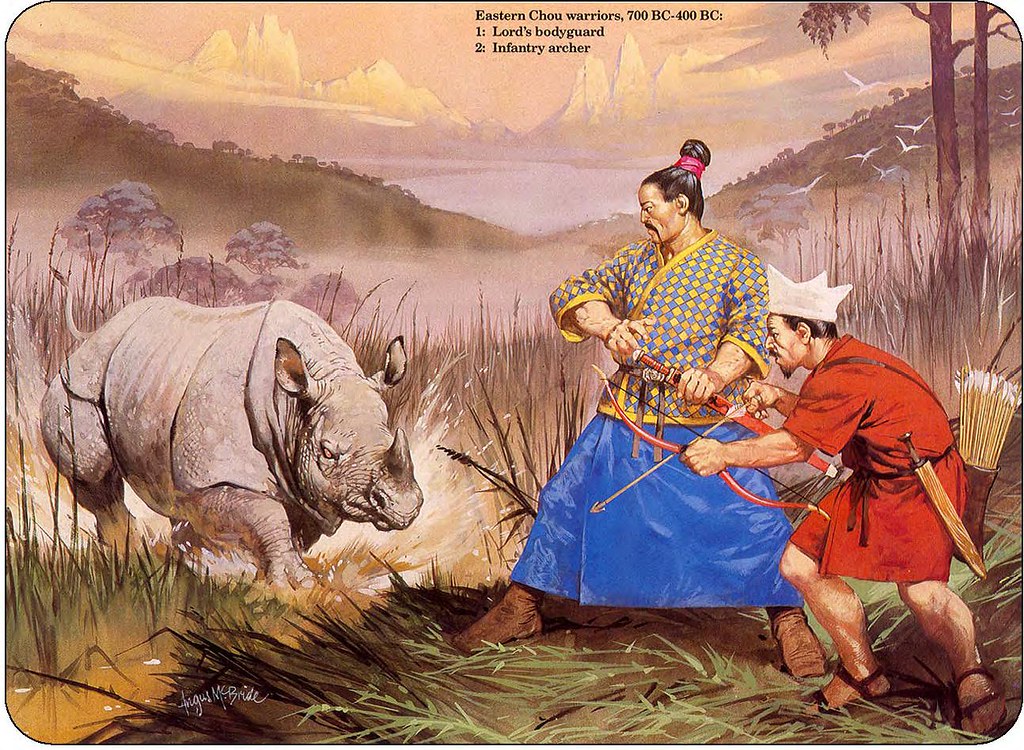
Eastern Chou warriors, 700-400 BC
The earliest known battle registered in China happened around the 26th century BC, called the Battle of Banquan, where the Yellow Emperor defeated the Yan Emperor. The same rea saw aso the Battle of Zhuolu where he defeated Chi You and established the Han Chinese civilisation. So it was perhaps the most decisive of all battles, and at a scale difficult to match in the west. Other major battles of the bronze age included the Battle of Mingtiao in 1675 BC, where the Xia dynasty is overthrown and replaced by the Shang dynasty, 1046 BC (Battle of Muye) which saw the demise of the Shang dynasty, replaced by the Zhou dynasty, in 707 BC the Battle of Xuge where the Western Zhou dynasty is defeated by the vassal Zheng state, 684 BC or Battle of Changshao which saw the Lu state defeating the Qi state and in 632 BC (Chengpu) the Jin crushing the state of Chu and in 627BC at Xiao defeating Qin. There will be numerous large battles in the IVth century until the decisive decade 230–221 BC known as the Qin's wars of unification, where the Qin state eventually subdued the six other major states, unifying the country under a single dynasty, and giving the country its name.
1500 BC: Bronze age Chinese warfare
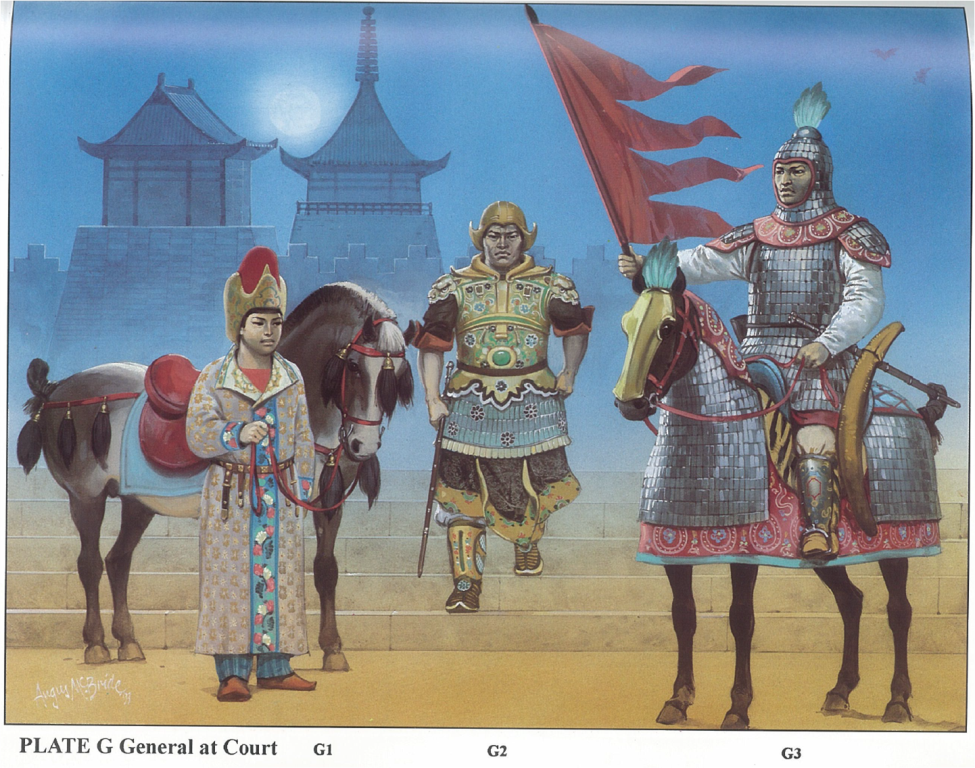
Hand in hand with the birth of the civilization goes and advanced agriculture, enough to ptocure surplus and reserve, allowing the birth of specialized workers and the emergence of classes of merchants, priests and naturally warriors, from which were often drawn the first rulers. The earthy power and spiritual often going hand in hand to dominate, manage and educate (to some extent) the masses. With the first cities, territories and resources management was born, and also appetites for loot for less favored, backwards and poorer populations turning into brigands. Warfare was about this before even ruler's ambitions went to declare war on neighbouring cities, embryos of city-states. Like in the West, the City-state (a walled city with surrounding rural areas and villages, as far as a man can go on foot in a day, or a horse can travel) model then prevailed.
The valley of Hwang Ho for example in bronze age China was dominated by a palace-based military caste owning its supremacy to a monopoly of bronze-working techniques. It enforced its rule over a still mainly Stone Age population, turned into slavery or forced labor. The rule of the first city-states was also the rule of knowledge and science; Technology often emerged thanks to crossings and exchanges. The Shang Dynasty saw war as both a way to legitimise the power of a new aristocracy.

Chariots, Western Chou, 800 BC
-200 BC - 580 AD: Early Imperial Chinese warfare
Of course the unification of China under Xin Chi Huangdi was the quickstart of a new era, a classic era of warfare. Previously, the After AD 304 the five 'barbarian' tribes divided north China among themselves, setting up dynasties which were often Chinese only in name, and feuding constantly both with each other and with the native states, whose stronghold was now in the south. It was under this barbarian influence that the heavily-armoured cavalry which were to become the striking force of the great T'ang dynasty in the 7th and 8th centuries first developed.Engagements at the time included the Qin dynasty battles (221–206 BC) which revolved around controlling the new area and borders, like the 215 BC campaign against the Xiongnu in the Ordos Desert and the newt year against the Yue tribes in southern China and northern Vietnam. However resentment grew in some parts of China and ten years later, rebellions erupted: In 209 BC the Dazexiang Uprising led by Chen Sheng and Wu Guang and in 207 BC the Battle of Julu which saw a rebel coalition army led by Xiang Yu defeating Qin forces. This was the equivalent of the Yellow turbans for the Han much later. Armies during the Qin-Han dynasties inherited their institutions from the Warring States Period but cavalry grew stronger in quality and numbers, especially under the han to answer the threat of the Xiongnu. Massive cavalry expeditions were launched and were ultimately successful, securing Northern and Western China, Mongolia, Central Asia, and Korea. Afterwards, they settled in an array of fortifications to fend of the rebellions of Qiang, Xianbei and Xiongnu. Whereas the Qin had a largely conscript army, the Eastern Han preferred paid volunteers and conscription was avoided by those bringing supplies, horses and slaves to the army instead of a fee.
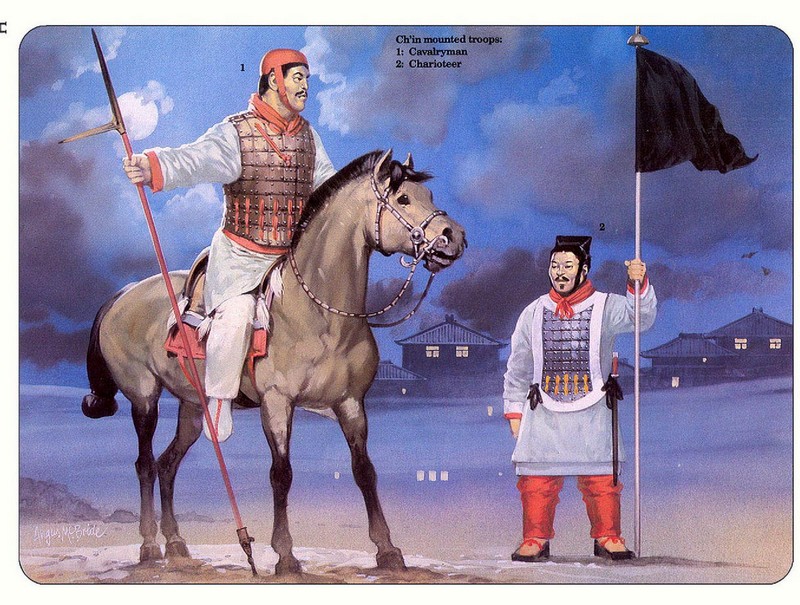
These troubled times saw the resurgence of the state of Chu and the Han, known as the Chu-Han Contention (206–202 BC). This saw a serie of back and forth battles yearly, until in 202 BC the Battle of Gaixia which saw the Han defeating Western Chu and unifying China under its own dynasty. The han will rule China for five centuries. During this time, the Han tried to contain the norwesthern Xiongnu tribes for decades. In 111 BC in what was called the Han–Nanyue War, the Han defeated the Nanyue kingdom, but this also led to the First Chinese domination of Vietnam. Expansion went on with two significant battles, in 109 BC against Dian (around present-day Yunnan) and further east, against the ancient Koreans the same year, in 109 BC the Gojoseon–Han War. At the time in the West the Roman Empire was stabilized under Emperor Augustus, protracted warfare against the Xiongnu had ceased for decades but internal tensions led to Battle of Kunyang in 23 AD, as Liu Xiu overthrown the Xin dynasty and restored the Eastern Han dynasty. Almost 20 years after rebellion erupted in the southwest, with the Trung sisters' rebellion which ended with the second occupation of Vietnam.
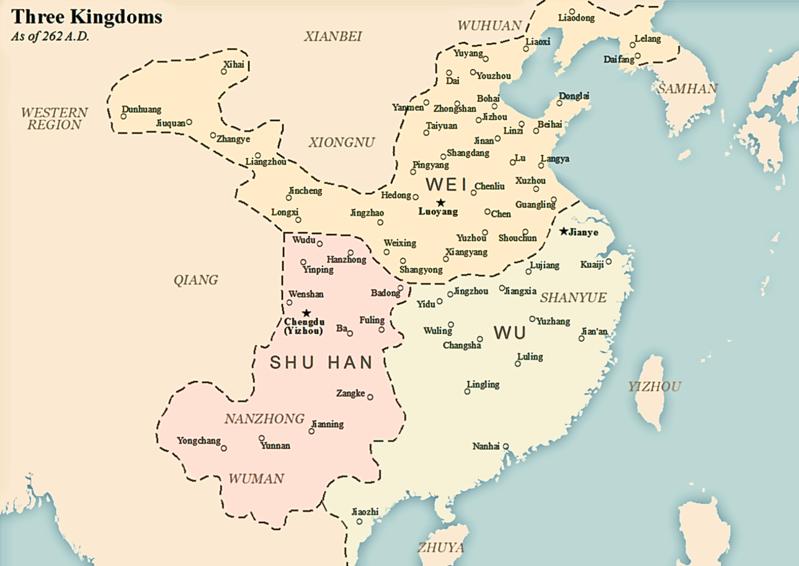
Map of the three kingdoms
In 184–205 AD started what became the famous Yellow Turban Rebellion. The Han forces eventully defeated the Yellow Turban rebels but the whole campaign was heavily romanticized in Chinese litterature in the monument called "the three kingdoms". One of the most significant battle of the era was in 208 AD at the Battle of Red Cliffs where Sun Quan (Southern state of Wu) and Liu Bei (Shu Han) defeat Cao Cao (Wei). The entire war ended in 263 by the Conquest of Shu by the state Wei led by Sima Yi and his descendents of the the Jin dynasty.
What followed was a long period of inter-states rivalry where China was ruled by the Jin dynasty (265–420), the Southern Dynasties (420–587), the Sixteen Kingdoms (304–439) and the Northern Dynasties (386–581). War seemed endemic when the seeing the list of battles, but in fact war was only a measure of last resort. After that startd in 589 the Conquest of Chen by Sui and the Chinese "early medieval" era, in reference to the end of the "dark age" in the West. Warfare did not change much but by the introduction of fire weapons, like the primitive "firelances" which were basically bamboo flamethrower. The explosive mixture was way less effective than the one later reinvented by the West, which was to replace one crucial component, held by China as strategic, by another.
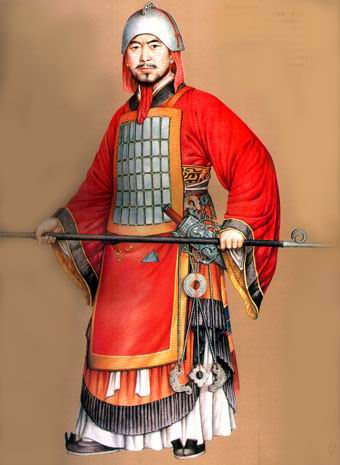
580-1260: Middle-Imperial Chinese warfare
In AD 589, when Yang Chien established himself at the head of a newly reformed Chinese empire, nearly four centuries had elapsed since the fall of the last great imperial dynasty: the Han. Although Yang's new Sui regime consciously modelled itself on its great predecessor, both China and the world outside had changed. The problem for the Sui and their successors was no longer simply to 'overawe the barbarians', but to deal as equals with other cultures that were just as proud and self-confident as their own. After that we enter the medieval era, which left our initial scope.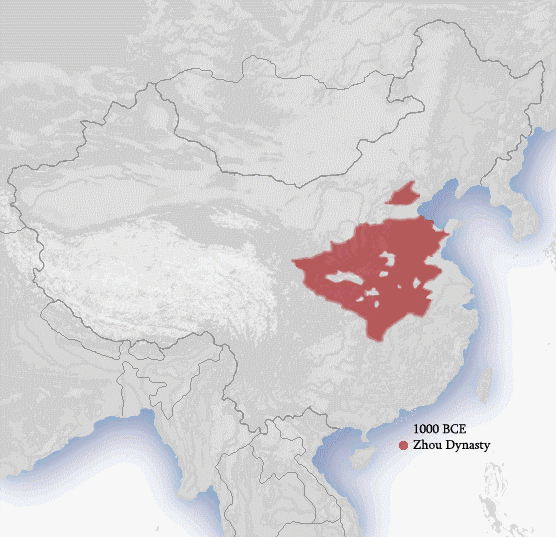
Ancient Chinese weaponry and armor
This wide subject is just enormous, so we will focus on ancient Chinese armament only, which alone is quite impressive. The Chinese indeed started using firelances (bamboo filled with crude gunpowder) only by the 10th century during the Jin-Song Wars, and 'rockets'Spears
Qiang
This was by far the widest family, almost a generic word for "spear" (槍), which inspired dozen of varieties according to their spearpoint. It was one of the four major weapons of ancient China, probably the one preferred by the troops because it was fast and easy to master, but it could also be used by masters. It was very similar to Western spears, and during the Song dynasty was known through nine different types, although their size was constant, fixed at about three meters (like the Greek Dory) in order to be used fast by two or one hand alternatively, the other handling a shield. But it was either up to 9 feet long (2.7m), and up to 14 or 21 feet, the latter used by two-handed pikemen. The Chinese indeed used phalanx formations about the same way as the Hellenistic Kingdoms; However, in time the Chinese spear gained tassel aids in order to blur the vision of an opponent, when using it fast, but also stopped the flow of blood from the blade from making the pole slippery.
Rome II Qin army, spearmen with the Ji
Ji
The grandfather of many Chinese polearms, of all qualities, for peasants and lords alike, including the famous Ge, and which also inspired the Japanese Yari and Naginata. This was a form of early halberd, rather than a spear in the sense the blade was shaped for multiple uses. It was a hybrid between a spear and a dagger-axe and a very common infantry weapon, but also used by cavalry and charioteers. The Song Dynasty Ju was developed from spears, and gave the qinglong ji (spear tiped by a crescent blade), Fangtian ji (crescent blades on both sides). Its long reach and multiple uses made it popular either against cavalry or infantry, especially for infantry that was unfit or not trained enough for melee combat.Ko (dagger-axe)
The standard polearm used from the Shang dynasty until the Han dynasty in China. Made of stone it evolved into bronze, and it combined an "axe" shaped as a blade, and a counter-pike on the other side of the pole. The Ji was developed from it by adding a spearpoint at the end of the pole. But at the beginning it was a pure "hook-style" weapon which demanded close formations, coordination in open terrain, privilege of large cities. More refined version was the Dagger scythe, with better shaped and pronounced hooks, and in iron. Massively used during the Warring States period (475–221 BC) they were the basic weapons of levied infantrymen. The Han dynasty relied on "Five Weapons" with the Ko as a standard, followed by the saber (dao), spear (Qiang), halberd (Ji), and staff (Gun). The Ko faded away during the Three Kingdoms era (184/220–280), in favor of the lighter spear.Guandao
A pole weapon made famous by heroes during the three kingdoms era, it was characterized by a large moon-shaped blade mounted on a 1.5 to 1.8 m pole. It was "invented" by legendary general Guan Yu, companion of Liu Bei, the Han statesman which controlled the state of Shu-Han. Guan Yu own wpon as nicknamed the "Green Dragon Crescent Blade". Other legendary general Zhang Fei's own polearm was called the "zhang long serpent spear".
Han Long Lances
Swords
The sword of Goujian
As an introduction to the greatest sword maker perhaps of all times, let's have a look of one of the most splendid example of metallurgy expertise from ancient times. From the "spring and autumn" period (approx. 771-476 BC) this 55.6 cm x 4.6 cm (handle 8.5 cm) symmetrical bronze sword had an exquisite artwork of intricate patterns with inserts of Turquoise. What is naffling experts and archaeologists to this day, behind its age, is the extreme sharpness of the blade, as if there was no degradation of the metal alloy over almost 3000 years and extreme resitance to tarnish, rarely seen. Technically bronze swords tend to be rust-resistance, as there is no iron added. Only copper and tin. With time bronze is degrading by oxydation, and turns green. Not the Goujian sword, which evern looked wel-polished and reflected even the dimest light. This sword of the state of Chu was discovered in a complex of ancient tombs. What was baffling is the massive presence of water in the tomb, which was soaked for 2000 years. The preservation of the sword, in addition to the casket in which it was found, was embedded in a superb scabbard finished in black laquer. The blade was mainly made of copper, while the edge comprised more tin, so it was flexible yet hard-cutting and the surface comprised sulfur which avoided the risk of tarnish. Inscription in a derivative of the ancient "seal script", 8 characters, were found, showing it was made for the king of Yue, probably GouJian. Showing an unrivalled level of craftmanship this sword was also a symbol of the upper class.
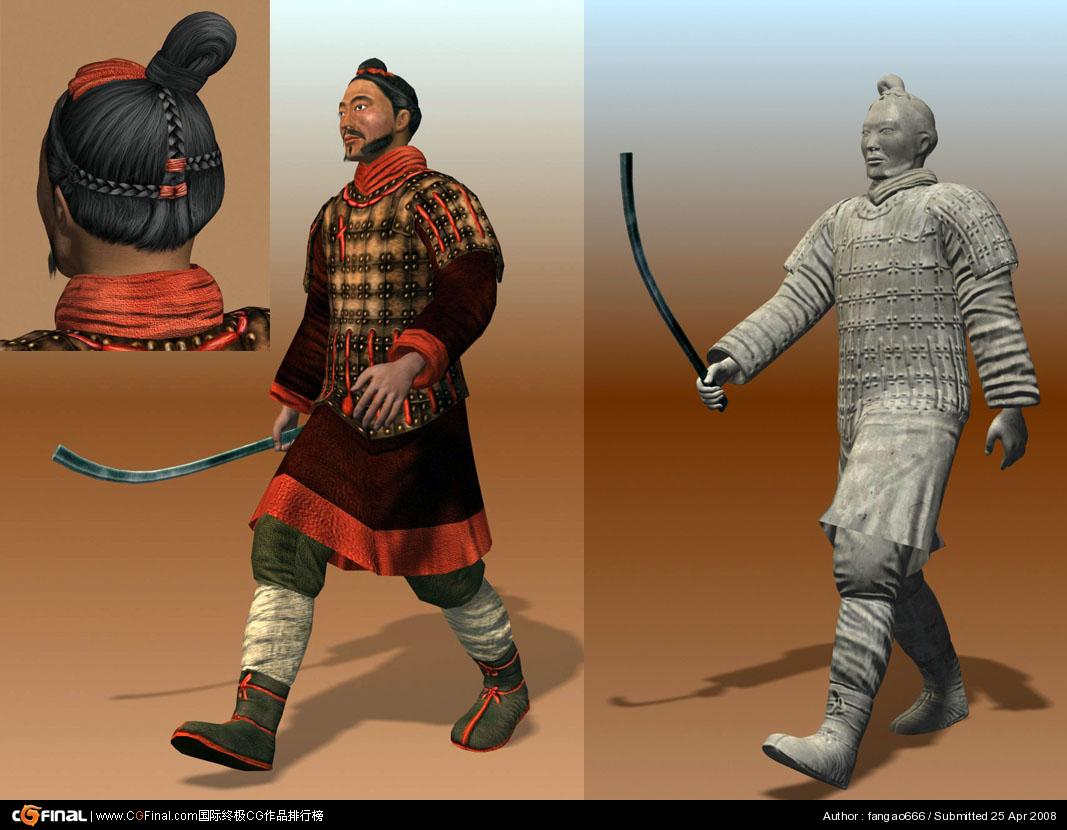
Rendition of a Qin warrior with a curved blade, of the Dao family.
Jian
Used as a generic term, this was the proverbial bronze-age straight and symmetrical, double-edged Chinese sword. Chinese swords were usually 70–110 cm in length, but they started as bronze shortswords during the Shang era. Just like in Europe, there were also two-handed shuangshou jian, which were up to 1.6 meters (63 inches) in length. It was the most common sword before being gradually replaced by the Dao during the Han dynasty, as the latter was much easier to master. Gradually the Jian became the main status symbol of the aristocratic elites, a sign of their martial abilities as well as to be able to gain possession exquisitely decorated objects praised as well an immense quality of workmanship. To see a good rendition of that Chinese passion for straight swords, see "hidden tiger and crouching dragon" movie. There was a pommel for balance, which was very important; Steel Jian of the Three Kingdoms era had a subtle profile taper which called for a level of metallurgy work then unrivalled worldwide. The way to use liberally different alloys in the blade made it both flexible and extremely hard on the edges, and inspired the Japanese Katana, as they were imported from Korea and first gave the Tsurugi. Martial arts still uses the Jian as a preferred weapon to showcase their expertise. The Taijiquan in particular is an extreme level of Kung Fu only reached by masters. However with time these "sports Jian" were widely more flexible than wartime blades.Dao
 Technically, the Dao was a pure saber, its name is a sign for "cutting", "slashing" and "chopping". It is the best known, longest-living weapon in China, still used at the time of the Japanese invasion in the 1930s. It emerged however during the Shang dynasty, called the zhibeidao (直背刀) as straight backed knives, made of bronze. During the warring state period they became iron sabres, and later steel. It was however less common than the popular jian, symmetrical double-edge sword. But it became the mainstay of Han cavalry, perhaps for the same reason Greek cavalry favored long chopping sabres such as the Machaira. It was also easy to master and became more common among infantry of the late Han, replacing the Jian which was much more difficult to master, while the later was reserved to the aristocratic elites, especially during the Three Kingdoms period. The dao was also coupled with polearms, creating impressive cavalry weapons with quite a long reach which became immensely popular during the years 200-300 AD. It began to diversify afterwards, like the Tang two-handed changdao ("long dao") or modao, and Peidao, Shoudao and Dadao, and of course the frightening "horse-cleaver" or Zhanmadao, which earned the same reputation of the Balkanic Romphaia.
Technically, the Dao was a pure saber, its name is a sign for "cutting", "slashing" and "chopping". It is the best known, longest-living weapon in China, still used at the time of the Japanese invasion in the 1930s. It emerged however during the Shang dynasty, called the zhibeidao (直背刀) as straight backed knives, made of bronze. During the warring state period they became iron sabres, and later steel. It was however less common than the popular jian, symmetrical double-edge sword. But it became the mainstay of Han cavalry, perhaps for the same reason Greek cavalry favored long chopping sabres such as the Machaira. It was also easy to master and became more common among infantry of the late Han, replacing the Jian which was much more difficult to master, while the later was reserved to the aristocratic elites, especially during the Three Kingdoms period. The dao was also coupled with polearms, creating impressive cavalry weapons with quite a long reach which became immensely popular during the years 200-300 AD. It began to diversify afterwards, like the Tang two-handed changdao ("long dao") or modao, and Peidao, Shoudao and Dadao, and of course the frightening "horse-cleaver" or Zhanmadao, which earned the same reputation of the Balkanic Romphaia.
Zhanmadao
 The origin of the Zanbato, ancestor of the Japanese Nodachi. It was used in 206 BC 220 AD during the han Dynasty. This was a very large sword, a chopper/cutter meaning "cavalry cutting sword". Curved, double-edged, straight, and evolved into a single-edge curved sword, still two-handed and quite heavy. The body was strainght and only the top/end was curved. The Japanese made it smaller and entirely curved, plus single-edge. The Japanese Nodachi, Odachi, Naginata, Nagamaki are all derived from this sword. Matchlock rifles, Muskets made them obsolete to kill horses.
The origin of the Zanbato, ancestor of the Japanese Nodachi. It was used in 206 BC 220 AD during the han Dynasty. This was a very large sword, a chopper/cutter meaning "cavalry cutting sword". Curved, double-edged, straight, and evolved into a single-edge curved sword, still two-handed and quite heavy. The body was strainght and only the top/end was curved. The Japanese made it smaller and entirely curved, plus single-edge. The Japanese Nodachi, Odachi, Naginata, Nagamaki are all derived from this sword. Matchlock rifles, Muskets made them obsolete to kill horses.
Blunt force weapons
Chuí
This "Hammer/Mace" was a Chinese melee weapon that consisted of a large, solid metal sphere on the end of a medium-long handle. The name was general for all weights ending a pole, wether they were civilian tools or military weapons. Mostly they were used by levies, but in war, picked up men chosen for their strenght were used to break shield formations with war hammers, which can be ended with a more effective spiked lead bowl.Gun
Not the english word, this was the traditional Chinese staff. One of the four most ancient weapons in tradition, it has been also called "The Grandfather of all Weapons". Although better known for its use in martial arts like in Wushu (in fact it was the very base of it), the staff could be an effective weapon, even lethal if well used; It was the same height of an average Chinese at 6 foot, but there was a shorter version known as the Bang and a longer one called the Chang Gun. It can be used either for thrust, using blunt force in targeted part of the body, or whacking blows, even propelling projectiles. Later were developed flail-like two section staffs and and three section staffs called sanjiegun which had nothing to do with the Okinawan San Bon Nunchaku. The staff was barely a "spear" in a sense it had no spearpoint.Flexible weapons
These were the Rome dart, flying claws, Fei Tou flying weight, and chain whip. Another related weapon was the "meteor hammer" or dai chui, flying hammer, or dragon's fist: Two lead balls linked by a chain. The rope dart was first used by the Tang Dynasty (618–907 AD). The flying claws appeared under the Sui dynasty in 581–618. There was a spring mechanism within the metal claw. The all-metal Chain whip as part of the Wushu tradition is relatively doubtful as a frontline weapon. It consisted in several metal rods, which are joined end-to-end by rings to form a flexible chain and frequently ended on one side by a handle and the other a dart. It appeared during the Jìn Dynasty (265-420). The articulated staff or sanjiegun is also part of this family and was developed from the gun, or staff. What is the Dragon beard hook ?Ranges Weapons: Bows
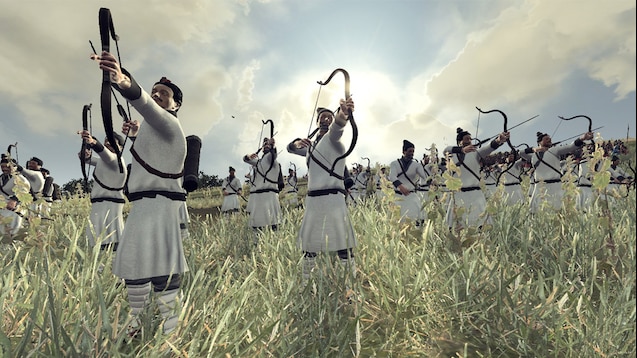
Qin archers
There is a long tradition here. The gong is the most ancient form of and this Chinese bow went back 4,000 years ago. Archery was also known as one of the six ancient arts that a gentleman must master. Composites bows were invented quite early, deduced from excavated bows found, of the Spring and Autumn period, and up to the Han dynasty (770 BCE–220 CE). These reflex bow was made from multiple layers of wood (such as bamboo or mulberry), wrapped in silk and lacquered. They could be smaller, had more range and were more powerful compared to eastern archers. It was also widely adopted by nomads. Mounted archery also was practiced on chariots from the prior to the Warring States period (475–221 BCE) and horse archers apparead right away. They were necessary during the Han era to deal with the Xiongnu and other border nomads. During tht time, Chinese horse archers left the robe and adopted nomadic-style jodhpurs. Infantry however swapped to the crossbow as soon as it was available, due to its quick and easy mastery, for the same reason it flourished in Europe. Bowmen were highly trained and specialized units. generally only the aristocratic elites, generals or high officers, and guards or crack troops had enough training to master it. The bulk of the arrow falling at the enemy was provided by crossbowmen. A few longbows were used for siege warfare during the Warring States era up to the Western Han Dynasty. Wood laminated bows became the staple of the humid south. Long-siyah horn bows made their apparition in the north, from the Han dynasty through the Yuan dynasty (206 BCE–1368 CE).
Crossbows (Nu)
 They generalized during the Qin rule and warring states era, as a way to equip large amounts of levied troops. However crossbow locks made of cast bronze have been found in China dating to around 650 BC. Called the Nu, one key development was the simple yet very efficient and innovative Chinese vertical trigger lock (photo). There was also a larger winch drawn crossbow type, and a variery of siege crossbow were developed. Either large crossbows used by besieging troops which loaded them by foot, seated on their butt, legs up, possibly even launching several arrows at once. There were also heavy double crossbows used on fixed positions, this time by the besieged. It was capable of reaching targets at great distances, like the Roman Ballista. better still, the Chinese also developed mounted triple bow crossbow (床弩) capable of reaching even greater distances at 450 meters and more, possibly also mounted on chariots and used in pitch battles. They were able to pierce through the toughest armor, and several men at once, and would be used with a great variety of arrowheads, like the feared crescent that can severe limbs at 600 yards.
They generalized during the Qin rule and warring states era, as a way to equip large amounts of levied troops. However crossbow locks made of cast bronze have been found in China dating to around 650 BC. Called the Nu, one key development was the simple yet very efficient and innovative Chinese vertical trigger lock (photo). There was also a larger winch drawn crossbow type, and a variery of siege crossbow were developed. Either large crossbows used by besieging troops which loaded them by foot, seated on their butt, legs up, possibly even launching several arrows at once. There were also heavy double crossbows used on fixed positions, this time by the besieged. It was capable of reaching targets at great distances, like the Roman Ballista. better still, the Chinese also developed mounted triple bow crossbow (床弩) capable of reaching even greater distances at 450 meters and more, possibly also mounted on chariots and used in pitch battles. They were able to pierce through the toughest armor, and several men at once, and would be used with a great variety of arrowheads, like the feared crescent that can severe limbs at 600 yards.
Repeating Crossbows (Lián Nŭ - 連弩)
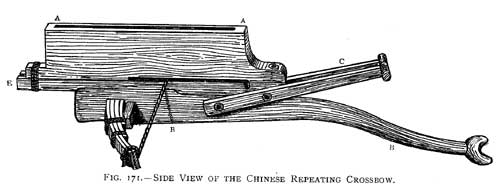 These amazing weapons were created during the warring states era (up to the Qin state's victory in 221 BC) which was romanized later as Chu-ko-nu and popularized during the Three Kingdoms era as "Zhuge crossbow", but this was never proven and he perhaps only refined it. The trigger mechanism but the earliest examples were double shot repeating crossbows using a pistol grip and a rear pulling mechanism for arming. But this cycle was obtained through less power and ultimately, it was a weak, short range (70 m at best), low velocity weapon requiring additional poisoned bolts to be effective. However it ws simple to operate, by simply pushing and pulling the lever back and forth, and widely adopted and used until the Ming dynasty. Of course firearms made it gradually disappear.
These amazing weapons were created during the warring states era (up to the Qin state's victory in 221 BC) which was romanized later as Chu-ko-nu and popularized during the Three Kingdoms era as "Zhuge crossbow", but this was never proven and he perhaps only refined it. The trigger mechanism but the earliest examples were double shot repeating crossbows using a pistol grip and a rear pulling mechanism for arming. But this cycle was obtained through less power and ultimately, it was a weak, short range (70 m at best), low velocity weapon requiring additional poisoned bolts to be effective. However it ws simple to operate, by simply pushing and pulling the lever back and forth, and widely adopted and used until the Ming dynasty. Of course firearms made it gradually disappear.
Chinese Catapult:
Called a traction trebuchet it first appeared in Ancient China during the 4th century BC as a siege weapon. Using a counterweight, it was adopted by the Avars later, then passed on to the Byzantines as the mangonel. In China the counterweight trebuchet replaced the traction trebuchet during the Song dynasty.Fire weapons:
Meng Huo You
Petrolum was already known in the Eastern Han Dynasty. However the flamethrower appeared as a weapon five centuries later and was used a several occasion, like during the defense of the city of Jiuquan in Gansu Province in the year 578, in fact long before the Byzantine's own devices. It was described as a chariot composed of a reservoir of petroleum or crude oil called "rock paint" and a piston, but its use was mostly static and gave way to gunpowder weapons quite soon.Huo Qiang (Fire lance)
Another "flamethrower" of ancient time, these combined a classic spear with a crude and rather inefficient gunpowder to produce flames relatively slowly. The goal was to either frighten the opponent, or blind him, allowing to hide the spearpoint and make a fatal move, although the flames were enough as a psychological effect. They are mentioned around the year 950 so a little bit out of this topic, and are used many times later, especially against the Mongols. Made of bamboo, one in 1259 fired a projectile, the first bullet in recorded history. Later bamboo gave way to metal barrels and both the gunpowder formula and projectiles made them early hanguns. Other, with larger barrels, threw pottery shards. They were used by cavalry as well.Note they were preceded by fire arrows, using the propelling force to increase their range, predating the rockets by centuries. Better still, in 1044 a "triple-bed-crossbow" firing fire arrows was described and tested, which predated the machine gun by almost 700 years (the puckle gun); The Ming dynasty also developed the San yan chong or three-barrel handgun and the Xun Lei Chong, a revolving spear combined musket or "Thundering fast firearm", also contender for the title of early machine gun. These five thin gun barrels were placed behind a reinforced shield, noted as "deadly at 150 paces". The other end had a spearpoint for defensive purposes.
Armor and protection
 Left: Bronze scale armor of the Han era. Chinese armour was predominantly lamellar. From the Warring States period (481 BC - 221 BC) it gradually replaced leather and more exotic materials such as rhinoceros hide and turtle shells, although the latter were used for a long time. Western and southern barbarians were known to use wicker shields and wooden protection. From the Han era, scale armor appeared, and as it was more flexible and protected better, was quickly generalized. Towards the end of antiquity, this slowel shifted towards partial plate armour, aspecially used by warriors from the Northern and Southern dynasties (420–589). Strangely, chainmail was never really adopted before the XIXth Century, imported from India, but the brigandine type ruled supreme.
Left: Bronze scale armor of the Han era. Chinese armour was predominantly lamellar. From the Warring States period (481 BC - 221 BC) it gradually replaced leather and more exotic materials such as rhinoceros hide and turtle shells, although the latter were used for a long time. Western and southern barbarians were known to use wicker shields and wooden protection. From the Han era, scale armor appeared, and as it was more flexible and protected better, was quickly generalized. Towards the end of antiquity, this slowel shifted towards partial plate armour, aspecially used by warriors from the Northern and Southern dynasties (420–589). Strangely, chainmail was never really adopted before the XIXth Century, imported from India, but the brigandine type ruled supreme.
During the bronze age, only Nobles used bronze helmets, but an interesting shell armor was uncovered. Shield were ofter made of bamboo covered with leather and skins were often used, sich as Toger skin both for ornament and prestige and offering some protection to horse. During the Zhou dynasty coats of rhinoceros or buffalo hide appeared, as well as an hardened leather scale armour. During the Warring States era, although Rhinoceros hide was a favorite among high rank warriors, but soon in the mid-4th century BC, lamellar armour made a hit. It was made entirel of riveted pieces or laced together. Hardened leather, wood, bronze, stone of iron were used. Bronze helmets which were relatively simple, with an opening only for the face, also generalized. Armies were better trained and equipped. However, armour was still reserved to the elites. Elite guard units for example.
Such a crack unit was a Chou state elite band of crossbowmen. The state of Han not only developed a large array of armor-piercing weaponry and developed specially trained units for breakthroughs, shieldreakers. Many of these elite melee warriors wore iron facemasks. The state of Qin set up a system of fines calculate, depending on the gravity of the offense, in coats of armour or shields. Armour also made its apparition on horsemen at the end of the 3rd century BC. During the three kingdoms era, while cavalrymen were equipped with their own armour, horse protection was limited to partial frontal barding. Armor and helmets became widespread as state standards and factories were setup. All warriors were now protected but some archers and crossbowmen, light vanguard cavalry, the rear guards, intendance and baggage train chariot men, but armour was crude, standardized and produced in large number in state arsenals. By far the most feared and revered protection ws the dark armour" (xuan kai) made of high quality, carbonated steel.
Shields varied in size and weight between light infantry and light to medium melee infantry, which needed to stay mobile, while one-handed spearmen were given larger shields. There were also pikemen without shields, since both hands were used to carry the pole weapon. These shields could be flat and wooden, but with some aesthetic design cut along the rim, or shaped like a bowl, and in bronze, perhaps influenced by the Greeks settled in the Indo-Greek kingdom. These large round shields were generally carried by elite imperial troops of the "feathered forest" type. During the Jin dynasty and Sixteen Kingdoms era (265–439), cataphracts began to appear, probably influenced by the Sai (Saka), and Parthians. Although it is beyond this topic in time, later appeared one of the most impressive scale armour ever designed, called the Mountain pattern armour.
It was made from intricate patterns of overlapping star-shaped pieces, and judge quite superior to scale armor as it was impenetrable from any angle while flexible. During the Ten Kingdoms (907–960) era, citizen militias were also armed with paper armor. These Tang "White Armor Armies" defeated professional armies of smaller scale, but these layers of silk paper functioned as a gambeson under other armour or by itself. The medieval to late-medieval Ming warriors started to use more liberally mail, but elites still used complex lamellar armour. During all this time, helmets did not evolved much. They had no front guard, neck guard nor cheekguards; ears were generally obstructed. However with Mongolian influence, this evolved, and the most common helmet recalls the European "pot" or "hat" type helmet with a large rim. Levies were often equipped with the round, flat, "rattan" shield.

Tactics and Formations
In the Shang dynasty (1766-1122 BC) Xiaotun tomb site already, chariots were buried into a “品” shape formation. The infantry was placed in a square formation.By 707 B.C., the state of Lu used the "Fish Scale Formation" in which chariots were placed at the front, and infantry squares filled in the intervals. In 690 BC, the kingdom of Chu decomposed the army into a vanguard, left and right wings, central army and rear guard. The state of Wu compensated its disuses of horses and chariots because of the southern mountainous terrain by using a formation where soldiers carried long shields and short swords and marched in square formations. During the Spring and Autumn period, Chinese armies formations usually comprised a vanguard, central army, left & right guards and the rear guard.
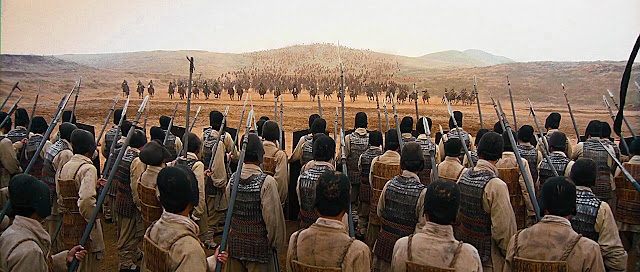
Qin phalanx

Han battle formation

8 trigrams formation
On the technical standpoint, the vanguard engage first the enemy first to test it out and judge its weaknesses and strenght. This vanguard comprised two rows with about 25 chariots in the first and 50 in the second. They would engage alternatively. Later, the left and right wing would press their attack from both sides. The central army would then advance in turn while the rear guard was often kept to protect the baggage train or as a reserve and in case of an encircling manoeuver. Coordination was made by bells, horns, flags, drums and messengers. Drums for the main orders in battle and bells to retreat while flags were basically to signal directions to regiments. These signs went as far as to indicate units postures such as kneeling, sitting, standing and spreading out (to avoid arrows). Orders were passed to the individual platoons levels via officers in the same hierarchical manner as in the Roman armies. The Han engaged in heavy melee combat with swords or axes, generally more seasons soldiers while spear-armed levies made large manoeuvers and took defensive stances.
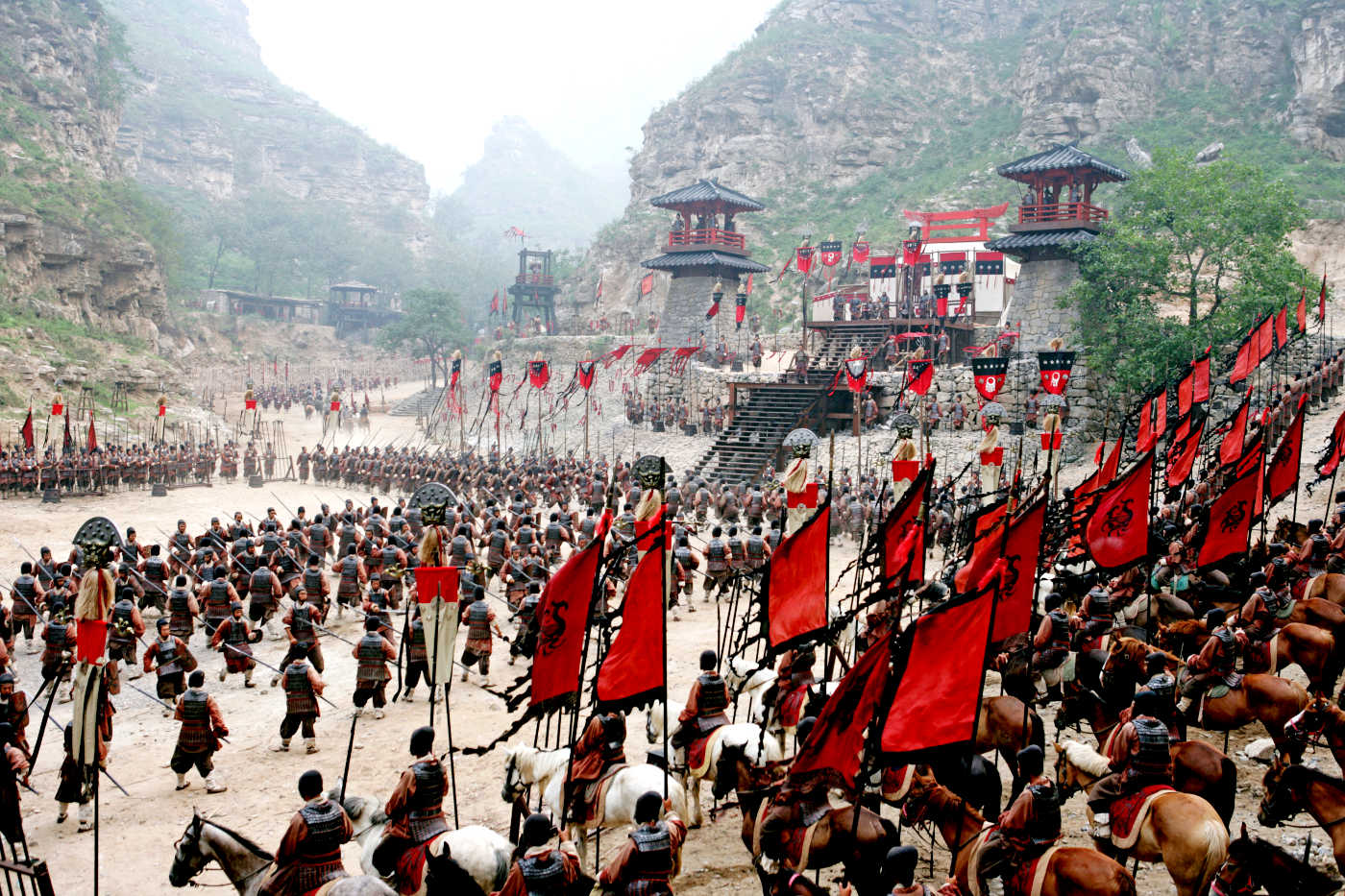
Red cliff: Formation tactical training
The classic, basic formation knowhow was called the “Ten Formations”. These were mastered by strategists as well as officers of various ranks, and consisted in a wedge (penetrating stance), square (standard manoeuver block), circle (defensive stance) formations, but also hook formation (to encircle), and more complicated formations like the goose, tiger, turtle... The goose formation was an encircling manoeuver while using cross-firing by flanking troops. https://www.quora.com/Were-Chinese-military-formations-more-technically-advanced-than-Roman-military-formations
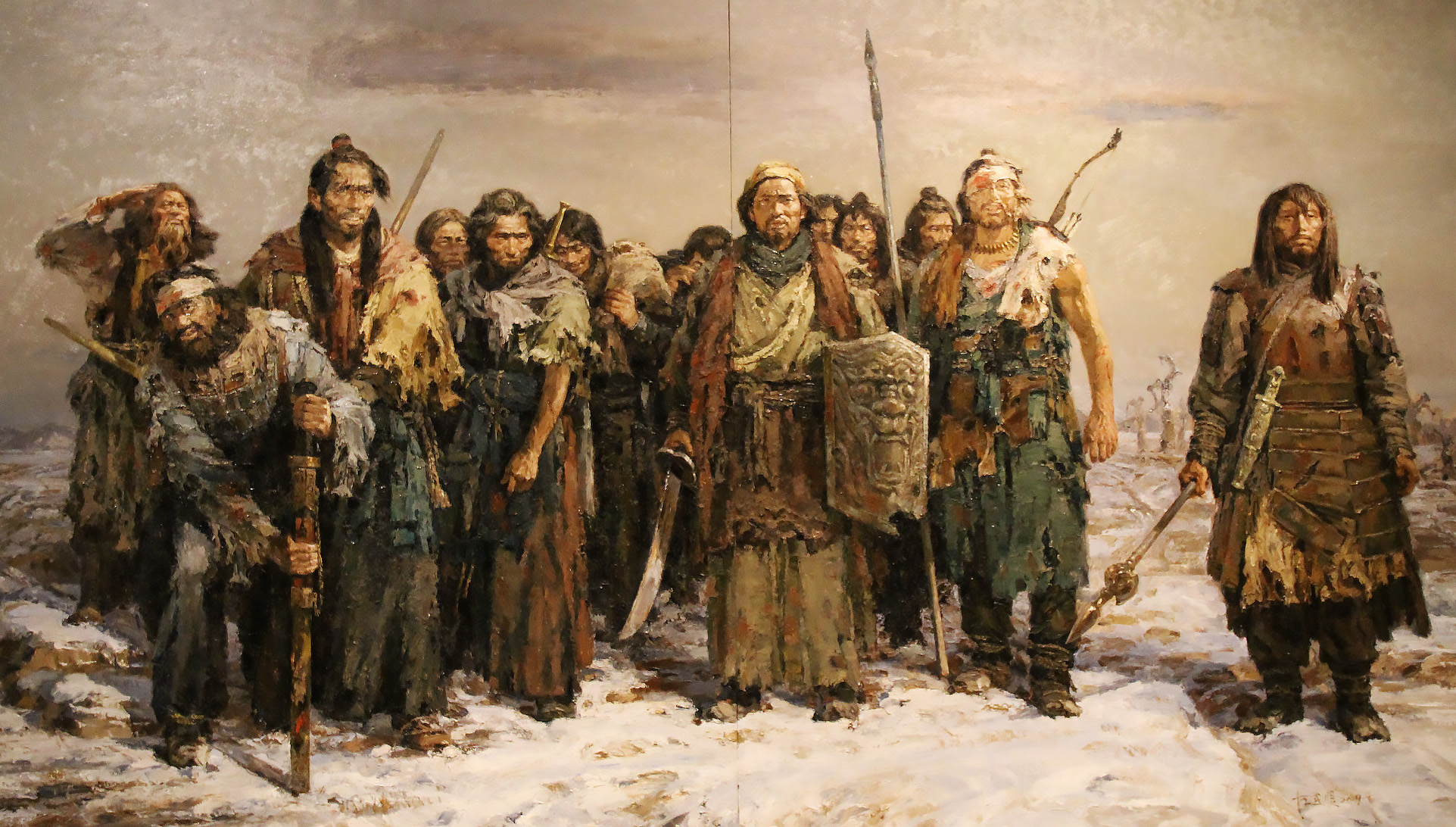
Enemies of the Han: The Xiongnu
Sources/Read More
ancient.eu - Chinese_WarfareList_of_Chinese_wars_and_battles
36 strategies an the I-Ching
Pictorial
---------Videos-----------
About warfare in ancient China (Dailymotion)
Metatron - The sword of Goujian
About ancient chinese bows
Generic about Chinese weaponry - History channel
---------Books-----------
Osprey men at arms ancient Chinese armies 1500 - 200 BC
Osprey men at arms Imperial Chinese armies (1) 200 BC - 590 AD
Osprey men at arms Imperial Chinese armies (2) 590 - 1260 AD
♕ Aquitani & Vasci ♕ Celts ♕ Indo-greeks ♕ Veneti ♕ Yuezhi ♕ Indians ♕ Etruscans ♕ Numidians ♕ Samnites ♕ Judaean ♕ Ancient Chinese ♕ Corsico-Sardinians
⚔ Cingetos ⚔ Immortals ⚔ Cavaros ⚔ Cataphract ⚔ Romphaiorioi ⚔ Chalkaspidai ⚔ Devotio Warrior ⚔ Scythian Horse archer ⚔ The Ambactos ⚔ Iberian warfare ⚔ Illyrian warriors ⚔ Germanic spearmen ⚔ Carthaginian Hoplite ⚔ Thracian Peltast ⚔ Caetrati ⚔ Ensiferi ⚔ Hippakontistai ⚔ Hastati ⚔ Gaesatae ⚔ Cretan Archer ⚔ Thorakitai ⚔ Soldurii ⚔ Iphikrates ⚔ Kardaka ⚔ The thureophoroi